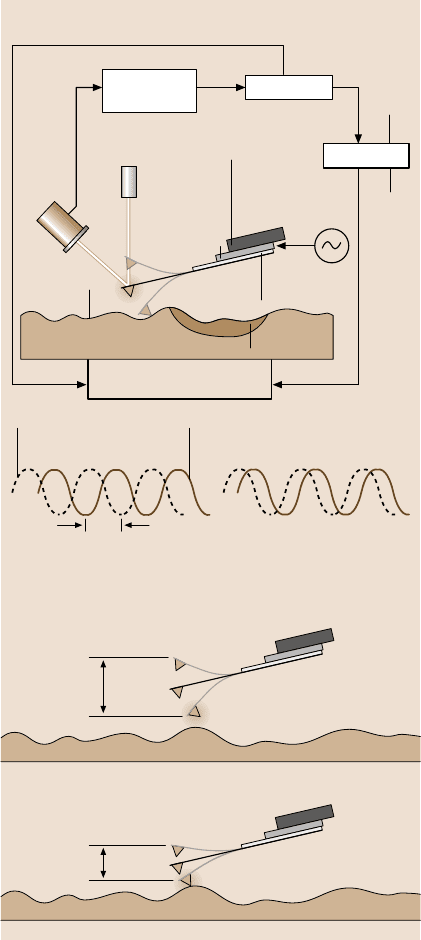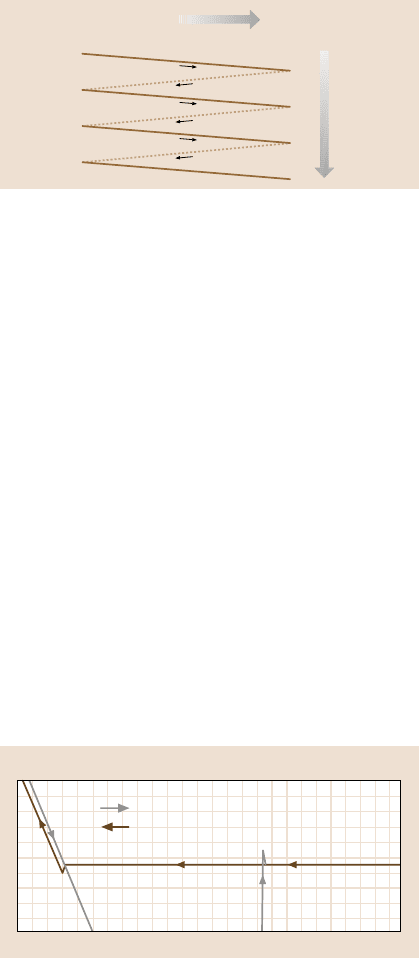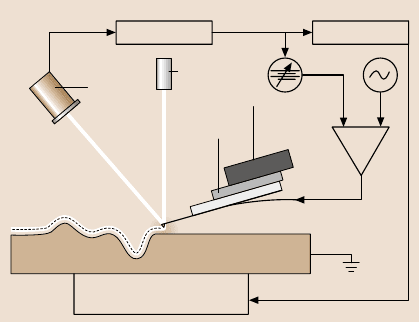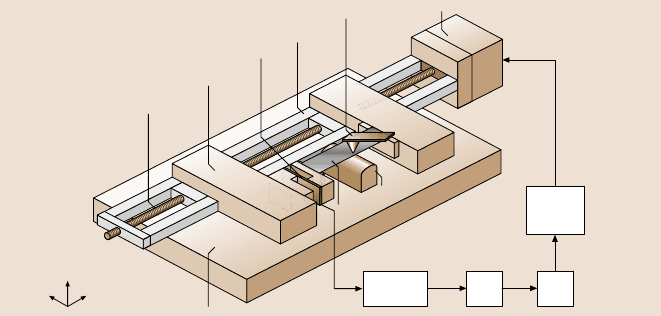Bhushan B. Nanotribology and Nanomechanics: An Introduction
Подождите немного. Документ загружается.

314 Bharat Bhushan
8.2 Description of AFM/FFM
and Various Measurement Techniques
An AFM was developedby Binnig and his colleagues in 1985. It is capable of inves-
tigating surfaces of scientific and engineering interest on an atomic scale [20,21].
The AFM relies on a scanning technique to produce very-high-resolution, three-
dimensional images of sample surfaces. It measures ultra-small forces (less than
1 nN) present between the AFM tip surface mounted on a flexible cantilever beam,
and a sample surface. These small forces are obtained by measuring the motion of
a very flexible cantilever beam having an ultra-small mass, by a variety of measure-
ment techniques including optical deflection, optical interference, capacitance, and
tunneling current. The deflection can be measured to within 0.02nm, so for a typi-
cal cantilever spring constant of 10 N/m, a force as low as 0.2 nN can be detected.
To put these numbers in perspective, individual atoms and human hair are typically
a fraction of a nanometer and about 75 µm in diameter, respectively, and a drop of
water and an eyelash have a mass of about 10µN and 100nN, respectively. In the
operation of high-resolution AFM, the sample is generally scanned rather than the
tip because any cantilever movement would add vibrations. AFMs are available for
measurement of large samples, where the tip is scanned and the sample is station-
ary. To obtain atomic resolution with the AFM, the spring constant of the cantilever
should be weaker than the equivalentspring between atoms. A cantilever beam with
a spring constant of about 1 N/m or lower is desirable. For high lateral resolution,
tips should be as sharp as possible. Tips with a radius in the range 10–100nm are
commonly available. Interfacial forces, adhesion, and surface roughness, including
atomic-scale imaging, are routinely measured using the AFM.
A modification to AFM, providing a sensor to measure the lateral force, led
to the development of the friction force microscope (FFM) or the lateral force mi-
croscope (LFM), designed for atomic-scale and microscale studies of friction [3–
5, 7, 8, 13, 22–37] and lubrication [38–43]. This instrument measures lateral or
friction forces (in the plane of the sample surface and in the scanning direction).
By using a standard or a sharp diamond tip mounted on a stiff cantilever beam,
AFM is used in investigations of scratching and wear [6, 9,13,27, 44–47], inden-
tation [9, 13,17, 27, 48–51], and fabrication/machining [4, 13, 27]. An oscillating
cantilever is used for localized surface elasticity and viscoelastic mapping, referred
to asdynamic AFM[35,52–60].In situsurface characterizationof localdeformation
of materials and thin coatings has been carried out by imaging the sample surfaces
using an AFM, during tensile deformation using a tensile stage [61–63].
8.2.1 Surface Roughness and Friction Force Measurements
Surface height imaging down to atomic resolution of electrically conducting sur-
faces is carried out using an STM. An AFM is also used for surface height imag-
ing and roughness characterization down to the nanoscale. Commercial AFM/FFM
are routinely used for simultaneous measurements of surface roughness and fric-
tion force [4, 11]. These instruments are available for measurement of small and

8 Nanotribology, Nanomechanics and Materials Characterization 315
large samples. In a small-sample AFM, shown in Fig. 8.2a, the sample, generally
no larger than 10 mm×10mm, is mounted on a piezoelectric crystal in the form
of a cylindrical tube [referred to as a lead zirconate titanate (PZT) tube scanner]
which consists of separate electrodes to scan the sample precisely in the x–y plane
in a raster pattern and to move the sample in the vertical (z) direction. A sharp
Laser diode,
collimator,
and lens
Laser path
Fixed
Mirror
Adjust-
able
mirror
Split-diode
photo-
detector
Lens
Mirror Lens
Camera
objective
lens
Sample
Cantilever holder
Motorized
stage
xyz PZT
tube scanner
x
y
z
x
y
b)
Fig. 8.2. Schematics (a) of a commercial small-sample atomic force microscope/friction force
microscope (AFM/FFM), and (b) of a large-sample AFM/FFM
316 Bharat Bhushan
tip at the free end of a flexible cantilever is brought in contact with the sample.
Normal and frictional forces being applied at the tip–sample interface are meas-
ured using a laser beam deflection technique. A laser beam from a diode laser is
directed by a prism onto the back of a cantilever near its free end, tilted down-
ward at about 10
◦
with respect to the horizontal plane. The reflected beam from
the vertex of the cantilever is directed through a mirror onto a quad photodetector
(split photodetector with four quadrants). The differential signal from the top and
bottom photodiodes provides the AFM signal, which is a sensitive measure of the
cantilever vertical deflection. Topographic features of the sample cause the tip to
deflect in the vertical direction as the sample is scanned under the tip. This tip de-
flection will change the direction of the reflected laser beam, changing the intensity
difference between the top and bottom sets of photodetectors (AFM signal). In the
AFM operating mode called the height mode, for topographic imaging or for any
other operation in which the applied normal force is to be kept constant, a feed-
back circuit is used to modulate the voltage applied to the PZT scanner to adjust the
height of the PZT, so that the cantilever vertical deflection (given by the intensity
difference between the top and bottom detector) will remain constant during scan-
ning. The PZT height variation is thus a direct measure of the surface roughness of
the sample.
In a large-sample AFM, both force sensors using optical deflection method and
scanning unit are mounted on the microscope head, Fig. 8.2b. Because of vibra-
tions added by cantilever movement, lateral resolution of this design is somewhat
poorer than the design in Fig. 8.2a in which the sample is scanned instead of can-
tilever beam. The advantage of the large-sample AFM is that large samples can be
measured readily.
Most AFMs can be used for surface roughness measurements in the so-called
tapping mode (intermittent contact mode), also referred to as dynamic (atomic)
force microscopy. In the tapping mode, during scanning over the surface, the
cantilever/tip assembly, with a normal stiffness of 20–100N/m (tapping mode
etched Si probe or DI TESP) is sinusoidally vibrated at its resonance frequency
(350–400kHz) by a piezo mounted above it, and the oscillating tip slightly taps
the surface. The piezo is adjusted using feedback control in the z-direction to main-
tain a constant (20–100nm) oscillating amplitude (set point) and constant aver-
age normal force (Fig. 8.3) [4, 11]. The feedback signal to the z-direction sam-
ple piezo (to keep the set point constant) is a measure of surface roughness. The
cantilever/tip assembly is vibrated at some amplitude, here referred to as the free
amplitude, before the tip engages the sample. The tip engages the sample at some
set point, which may be thought of as the amplitude of the cantilever as influenced
by contact with the sample. The set point is defined as a ratio of the vibration am-
plitude after engagement to the vibration amplitude in free air before engagement.
A lower set point gives a reduced amplitude and closer mean tip-to-sample dis-
tance. The amplitude should be kept large enough so that the tip does not get stuck
to the sample because of adhesive attractions. Also the oscillating amplitude applies
a lower average (normal) load compared to the contact mode and reduces sample

8 Nanotribology, Nanomechanics and Materials Characterization 317
Computer
Height
data
Phase
data
Material 2
Viscoelastic material
Nearly elastic material
Cantilever
in free air
Cantilever
response
Phase angle
Tapping mode phase imaging
2 × set-point
2 × free
amplitude
Before
engagement
AFM setting
definitions
During
engagement
Sample
x-y controlz control x-y-z piezo
Canti-
lever
piezo
Substrate
holder
Cantilever
substrate
Laser
Photo-
detector
Material 1
Extender
electronics
Controller
Fig. 8.3. Schematic of tap-
ping mode used to obtain
height and phase data and
definitions of free ampli-
tude and set point. During
scanning, the cantilever is
vibrated at its resonance fre-
quency and the sample x–y–z
piezo is adjusted by feedback
control in the z-direction to
maintain a constant set point.
The computer records height
(which is a measure of sur-
face roughness) and phase
angle (which is a function of
the viscoelastic properties of
the sample) data
damage. The tapping mode is used in topography measurements to minimize the
effects of friction and other lateral forces and to measure the topography of soft
surfaces.
318 Bharat Bhushan
For the measurement of the friction force at the tip surface during sliding, left-
hand and right-hand sets of quadrants of the photodetector are used. In the so-called
friction mode, the sample is scanned back and forth in a direction orthogonal to the
long axis of the cantilever beam. A friction force between the sample and the tip
will produce a twisting of the cantilever. As a result, the laser beam will be reflected
out of the plane defined by the incident beam and the beam reflected vertically from
an untwisted cantilever. This produces an intensity difference of the laser beam re-
ceived in the left-hand and right-handsets of quadrants of the photodetector.The in-
tensity difference between the two sets of detectors (FFM signal) is directly related
to the degree of twisting and hence to the magnitude of the friction force. One prob-
lem associated with this method is that any misalignment between the laser beam
and the photodetector axis would introduce error in the measurement. However, by
following the procedures developed by Ruan and Bhushan [24], in which the aver-
age FFM signal for the sample scannedin two oppositedirections is subtractedfrom
the friction profiles of each of the two scans, the misalignment effect is eliminated.
This method provides three-dimensional maps of friction force. By following the
friction force calibration procedures developed by Ruan and Bhushan [24], voltages
corresponding to friction forces can be converted to force units. The coefficient of
friction is obtained from the slope of friction force data measured as a function of
normal loads typically ranging from 10 to 150nN. This approach eliminates any
contributions due to the adhesive forces [27]. For calculation of the coefficient of
friction based on a single-point measurement, friction force should be divided by
the sum of applied normal load and intrinsic adhesive force. Furthermore it should
be pointed out that, for a single asperity contact, the coefficient of friction is not
independent of load (see discussion later).
Surface roughness measurements in the contact mode are typically made using
a sharp, microfabricated square-pyramidal Si
3
N
4
tip with a radius of 30–50nm on
a triangular cantilever beam (Fig. 8.4a) with normal stiffness on the order of 0.06–
0.58N/m with a normal natural frequency of 13–40kHz (silicium nitride probe
or DI NP) at a normal load of about 10nN, and friction measurements are carried
out in the load range of 1–100nN. Surface roughness measurements in the tapping
mode utilize a stiff cantilever with high resonance frequency; typically a square-
pyramidal etched single-crystal silicon tip, with a tip radius of 5–10 nm, integrated
with a stiff rectangular silicon cantilever beam (Fig. 8.4a) with a normal stiffness
on the order of 17–60N/m and a normal resonance frequency of 250–400kHz (DI
TESP), is used. Multiwalled carbon nanotube tips having small diameter (a few nm)
and a length of about 1µm (high aspect ratio), attached to the single-crystal silicon
square-pyramidal tips are used for high-resolution imaging of surfaces and of deep
trenches in the tapping mode (noncontactmode) (Fig. 8.4b) [64]. To study the effect
of the radiusof a singleasperity (tip) on adhesionand friction, microspheresof silica
with radii rangingfrom about 4 to 15 µm are attached at the endof cantilever beams.
Optical micrographs of two of the microspheres at the ends of triangular cantilever
beams are shown in Fig. 8.4c.

8 Nanotribology, Nanomechanics and Materials Characterization 319
Fig. 8.4. (a) SEM micrographs of a square-pyramidal PECVD Si
3
N
4
tip with a triangular
cantilever beam, a square-pyramidal etched single-crystal silicon tip witha rectangular silicon
cantilever beam, and a three-sided pyramidal natural diamond tip with a square stainless-steel
cantilever beam, (b) SEM micrograph of a multiwalled carbon nanotube (MWNT) physically
attached to the single-crystal silicon, square-pyramidal tip, and (c) optical micrographs of
commercial Si
3
N
4
tip and two modified tips showing SiO
2
spheres mounted over the sharp
tip, at the end of the triangular Si
3
N
4
cantilever beams (radii of the tips are given in the
figure)
The tip is scanned in such a way that its trajectory on the sample forms a trian-
gular pattern, Fig. 8.5. Scanning speeds in the fast and slow scan directions depend
on the scan area and scan frequency. Scan sizes ranging from less than 1nm×1nm
to 125µm×125µm and scan rates from less than 0.5 to 122Hz can typically be
used. Higher scan rates are used for smaller scan lengths. For example, scan rates in
the fast and slow scan directions for an area of 10µm×10µm scanned at 0.5Hzare
10µm/s and 20nm/s, respectively.

320 Bharat Bhushan
Fast scan direction Slow scan
direction
Fig. 8.5. Schematic of trian-
gular pattern trajectory of the
tip as the sample (or the tip)
is scanned in two dimensions.
During scanning, data are
recorded only during scans
along the solid scan lines
8.2.2 Adhesion Measurements
Adhesiveforce measurementsare performedin the so-called forcecalibration mode.
In this mode, force–distance curves are obtained; for an example see Fig. 8.6. The
horizontal axis gives the distance the piezo (and hence the sample) travels and the
vertical axis gives the tip deflection. As the piezo extends, it approaches the tip,
which is at this point in free air and hence shows no deflection. This is indicated by
the flat portion of the curve. As the tip approaches the sample within a few nanome-
ters (point A), an attractive force exists between the atoms of the tip surface and
the atoms of the sample surface. The tip is pulled towards the sample and contact
occurs at point B on the graph. From this point on, the tip is in contact with the
surface and, as the piezo further extends, the tip is further deflected. This is repre-
sented by the sloped portion of the curve. As the piezo retracts, the tip goes beyond
the zero-deflection (flat) line because of attractive forces (van der Waals forces and
long-range meniscus forces), into the adhesive regime. At point C on the graph, the
tip snaps free of the adhesive forces, and is again in free air. The horizontal distance
between points B and C along the retrace line gives the distance moved by the tip
in the adhesive regime. This distance multiplied by the stiffness of the cantilever
gives the adhesive force. Incidentally, the horizontal shift between the loading and
unloading curves results from the hysteresis in the PZT tube [4,11].
Tip deflection (6 nm/div)
PZT vertical position (15 nm/div)
Retracting
Extending
C
B
A
Fig. 8.6. Typical force–distance curve for a contact between Si
3
N
4
tip and single-crystal
silicon surface in measurements made in the ambient environment. Contact between the tip
and silicon occurs at point B; the tip breaks free of adhesive forces at point C as the sample
moves away from the tip
8 Nanotribology, Nanomechanics and Materials Characterization 321
8.2.3 Scratching, Wear and Fabrication/Machining
For microscale scratching, microscale wear, nanofabrication/nanomachining and
nanoindentationhardness measurements, an extremely hard tip is required.A three-
sided pyramidal single-crystal natural-diamond tip with an apex angle of 80
◦
and
a radius of about 100nm mounted on a stainless-steel cantilever beam with normal
stiffness of about 25N/m is used at relatively higher loads (1–150µN),Fig.8.4a.
For scratching and wear studies, the sample is generally scanned in a direction or-
thogonal to the long axis of the cantilever beam (typically at a rate of 0.5Hz)so
that friction can be measured during scratching and wear. The tip is mounted on
the cantilever such that one of its edges is orthogonal to the long axis of the beam;
therefore, wear during scanning along the beam axis is higher (about 2 to 3 times)
than that during scanning orthogonal to the beam axis. For wear studies, an area
on the order of 2µm ×2µm is scanned at various normal loads (ranging from 1 to
100µN) for a selected number of cycles [4,11,45].
Scratching can also be performed at ramped loads and the coefficient of fric-
tion can be measured during scratching [47]. A linear increase in the normal load
approximated by a large number of normal load increments of small magnitude is
appliedusing a software interface(lithographymodulein NanoscopeIII) that allows
the user to generate controlled movement of the tip with respect to the sample. The
friction signal is tapped out of the AFM and is recorded on a computer. A scratch
length on the order of 25µm and a velocity on the order of 0.5µm/s are used and
the number of loading steps is usually taken to be 50.
Nanofabrication/nanomachining is conducted by scratching the sample surface
with a diamond tip at specified locations and scratching angles. The normal load
used for scratching (writing) is on the order of 1–100µN with a writing speed on
the order of 0.1–200µm/s [4,6,11–13,27,65].
8.2.4 Surface Potential Measurements
To detect wear precursors and to study the early stages of localized wear, the multi-
mode AFM can be used to measure the potential difference between the tip and the
sample by applying a DC bias potential and an oscillating (AC) potential to a con-
ducting tip over a grounded substrate in a Kelvin probe microscopy or so-called
nano-Kelvin probe technique [66–68].
Mapping of the surface potential is made in the so-called lift mode (Fig. 8.7).
These measurements are made simultaneously with the topography scan in the tap-
ping mode, using an electrically conducting (nickel-coated single-crystal silicon)
tip. After each line of the topography scan is completed, the feedback loop control-
ling the vertical piezo is turned off, and the tip is lifted from the surface and traced
over the same topography at a constant distance of 100 nm. During the lift mode,
a DC bias potential and an oscillating potential (3–7Volts) is applied to the tip. The
frequency of oscillation is chosen to be equal to the resonance frequency of the can-
tilever (≈ 80kHz). When a DC bias potential equal to the negative value of surface
potential of the sample (on the order of ±2Volts) is applied to the tip, it does not

322 Bharat Bhushan
Sum
Feedback Computer
Photo-
detector
Sample
xyz control
xyz piezo
Canti-
lever
piezo
Substrate
holder
Laser
Fig. 8.7. Schematic of lift mode used to make surface potential measurement. The topography
is collected in tapping mode in the primary scan. The cantilever piezo is deactivated. Using
topography information of the primary scan, the cantilever is scanned across the surface at
a constant height above the sample. An oscillating voltage at the resonant frequency is ap-
plied to the tip and a feedback loop adjusts the DC bias of the tip to maintain the cantilever
amplitude at zero. The output of the feedback loop is recorded by the computer and becomes
the surface potential map
vibrate. During scanning, a difference between the DC bias potential applied to the
tip and the potential of the surface will create DC electric fields that interact with
the oscillating charges (as a result of the AC potential), causing the cantilever to os-
cillate at its resonance frequency,as in the tapping mode. However, a feedback loop
is used to adjust the DC bias on the tip to exactly nullify the electric field, and thus
the vibrations of the cantilever. The required bias voltage follows the localized po-
tential of the surface. The surface potential was obtained by reversing the sign of the
bias potential provided by the electronics [67,68]. Surface and subsurface changes
of structure and/or chemistry can cause changes in the measured potential of a sur-
face. Thus, mapping of the surface potential after sliding can be used to detect wear
precursors and study the early stages of localized wear.
8.2.5 In Situ Characterizationof Local Deformation Studies
In situ characterization of local deformation of materials can be carried out by per-
forming tensile, bending, or compression experiments inside an AFM and by ob-
serving nanoscale changes during the deformation experiment [17]. In these exper-
iments, small deformation stages are used to deform the samples inside an AFM.
In tensile testing of the polymeric films carried out by Bobji and Bhushan [61,62]
and Tambe and Bhushan [63] a tensile stage was used (Fig. 8.8). The stage with
a left–right combination lead screw (which helps to move the slider in the opposite
direction) was used to stretch the sample to minimize the movement of the scan-
ning area, which was kept close to the center of the tensile specimen. One end of

8 Nanotribology, Nanomechanics and Materials Characterization 323
Stepper motor
Stepper
motor
controller
Signal
conditioner
A/D
board
PC
Base
plate
Left-right
lead screw
Slider
Stage
AFM
tip
Sample
Support
Force
sensor
z
xy
Fig. 8.8. Schematic of the tensile stage to conduct in situ tensile testing of the polymeric films
in AFM
the sample was mounted on the slider via a force sensor to monitor the tensile load.
The samples were stretched for various strains using a stepper motor and the same
control area at different strains was imaged. In order to better locate the control area
for imaging, a set of four markers was created at the corners of a 30 µm×30µm
square at the center of the sample by scratching the sample with a sharp silicon tip.
The scratching depth was controlled such that it did not affect the cracking behavior
of the coating. A minimum displacement of 1.6µm could be obtained. This cor-
responded to a strain increment of 8×10
−3
% for a sample length of 38 mm. The
maximum travel was about 100mm. The resolution of the force sensor was 10mN
with a capacity of 45N. During stretching, a stress–strain curve was obtained dur-
ing the experiment to study any correlation between the degree of plastic strain and
propensity of cracks.
8.2.6 Nanoindentation Measurements
For nanoindentation hardness measurements the scan size is set to zero and then
a normal load is applied to make the indents using the diamond tip (see Sect. 8.2.5).
During this procedure, the tip is continuously pressed against the sample surface
for about two seconds at various indentation loads. The sample surface is scanned
before and after the scratching, wear or indentation to obtain the initial and the final
surface topography, at a low normal load of about 0.3µN using the same diamond
tip. An area larger than the indentation region is scanned to observe the indentation
marks. Nanohardness is calculated by dividing the indentation load by the projected
residual area of the indents [50].
Direct imaging of the indent allows one to quantify piling up of ductile material
around the indenter. However,it becomes difficult to identify the boundaryof the in-
dentation mark with great accuracy. This makes the direct measurement of contact
area somewhat inaccurate. A technique with the dual capability of depth-sensing as
